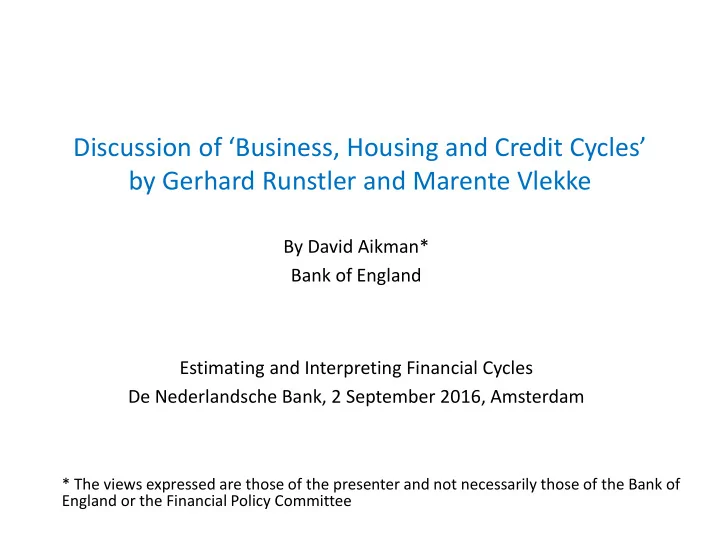

Discussion of ‘Business, Housing and Credit Cycles’ by Gerhard Runstler and Marente Vlekke By David Aikman* Bank of England Estimating and Interpreting Financial Cycles De Nederlandsche Bank, 2 September 2016, Amsterdam * The views expressed are those of the presenter and not necessarily those of the Bank of England or the Financial Policy Committee
Overview • Very nice paper with some interesting results, some of which corroborate findings in the existing literature, others of which are more novel • Method • Main results • Comments – What mechanism is capable of generating 15 year cycles of this sort? – The relationship between housing markets and the length of cycles – What do the results say about the policy stance at the current juncture? Thoughts on the usefulness of this approach in a policy setting
Method • RV develop a multivariate filter to capture the join dynamics of real GDP, real credit and real house prices • Method is an augmented version of Harvey and Koopman (1997) • To add
Main results • Result 1: RV find long and large cycles in credit and house prices – In line with various earlier studies (eg Drehmann et al, 2012 and Aikman et al, 2015), • Result 2: Financial cycles differ markedly across countries – US, Italy and France: annual cycle length is 12-15 years; standard deviation of credit cycle is 4-6% and house prices 10-12% – UK and Spain: longer and larger (annual cycle length is 16-19 years; standard deviation of credit cycle is 19-21% and house prices 8-14%) – Germany: smaller and shorter (annual cycle length is 6-7 years; standard deviation of credit cycle is 1% and house prices 3%) • Result 3: Strength of financial cycles correlated with shares of private home ownership in national housing markets
Main results • Result 4: Credit and house price cycles are closely correlated with the medium-term component in GDP – Correlation is high for medium run cycles, but only moderate at traditional business cycle frequencies (<32 quarters) – Medium run cycles in house prices are contemporaneous with GDP while credit lags • Result 5: Uncertainty of real-time cycle estimates is comparable to that of business cycles when normalised by the size of cycles – Using parameter estimates based on data to 2000, model fails to detect mid-2000s credit boom for 2 out of 5 countries
Comment #1: What new insight do we get from RV’s approach? • The paper would benefit from more discussion of how the basic results differ those found elsewhere in the literature or those found using simpler methods • For instance, how does the narrative one gets of the financial cycle change using this method? The credit cycle obtained for the UK using RV’s method looks quite similar to what one obtains by applying a simple HP filter…
RV estimated credit cycle for the United Kingdom versus a simple 2-sided HP filter RV credit cycle Simple smoothed HPfilter 0,3 0,2 0,1 0 1970 1975 1980 1985 1990 1995 2000 2005 2010 -0,1 -0,2 -0,3
Comment #2: What mechanism is capable of generating long-lived cycles of this sort? • The next step for this literature needs to be thinking about structural mechanisms capable of explaining why cycles of such persistence can arise • In my experience, the lack of such a mechanism is a major barrier for some to believe these results • There are some papers in the literature that provide some possible clues: – Comin and Gertler (2006, AER and subsequent papers): RBC-style model in which business cycle shocks (eg to markups) influence the pace of R&D innovation and adoption, which in turn generates large persistent movements in productivity – Aghion et al (2010): interaction between credit constraints, liquidity shocks, horizon of investment and growth – Burnside et al (2016, JPE): endogenous fads in the proportion of the population that are optimistic/pessimistic about housing fundamentals – Schleifer and Vishny (2012, JFE): agents neglect tail risks in tranquil times
Comment #3: Strength of cycles and housing markets • An interesting finding of the paper is that the strength of financial cycles is correlated with home ownership rates: Cycle length and standard deviation is correlated with home ownership rates in the cross section – Is there also a possible relationship with the level of indebtedness? • Home ownership rates have varied considerably over the past century in many countries. For the UK: – In 1918, 77% of households in England and Wales rented – Home ownership rates began to increase in early 1950s – Reached 69% in 2001 but have since fallen • For the UK, not clear these structural shifts have been associated with similar shifts in the strength of the financial cycle (see Aikman, Nelson, Haldane, 2013)
Medium term cycle for credit for the UK (Aikman, Nelson, Haldane, 2013, EJ )
Comment #4: Policy implications • The questions we often get asked are: • - what is the sustainable path of credit for the economy? Where do we expect the growth rate of credit to settle down in the aftermath of the crisis? And when should we worry? • - should we be focusing on de-trended estimates of the financial cycle or should we instead be concentrating on large shifts in the level of indebtedness? Or is it the distribution of indebtedness that really matters? • Crudely: are vulnerabilities in the financial system high (as implied by the level of indebtedness) or low (as implied by filtered gap estimates) right now?
100,00 150,00 200,00 -50,00 50,00 0,00 mrt-80 apr-81 mei-82 jun-83 UK Credit-to-GDP ratio and gap jul-84 aug-85 sep-86 okt-87 nov-88 dec-89 jan-91 Credit-to-GDP ratio feb-92 mrt-93 apr-94 mei-95 jun-96 jul-97 aug-98 sep-99 Credit-to-GDP gap okt-00 nov-01 dec-02 jan-04 feb-05 mrt-06 apr-07 mei-08 jun-09 jul-10 aug-11 sep-12 okt-13 nov-14 dec-15
Recommend
More recommend